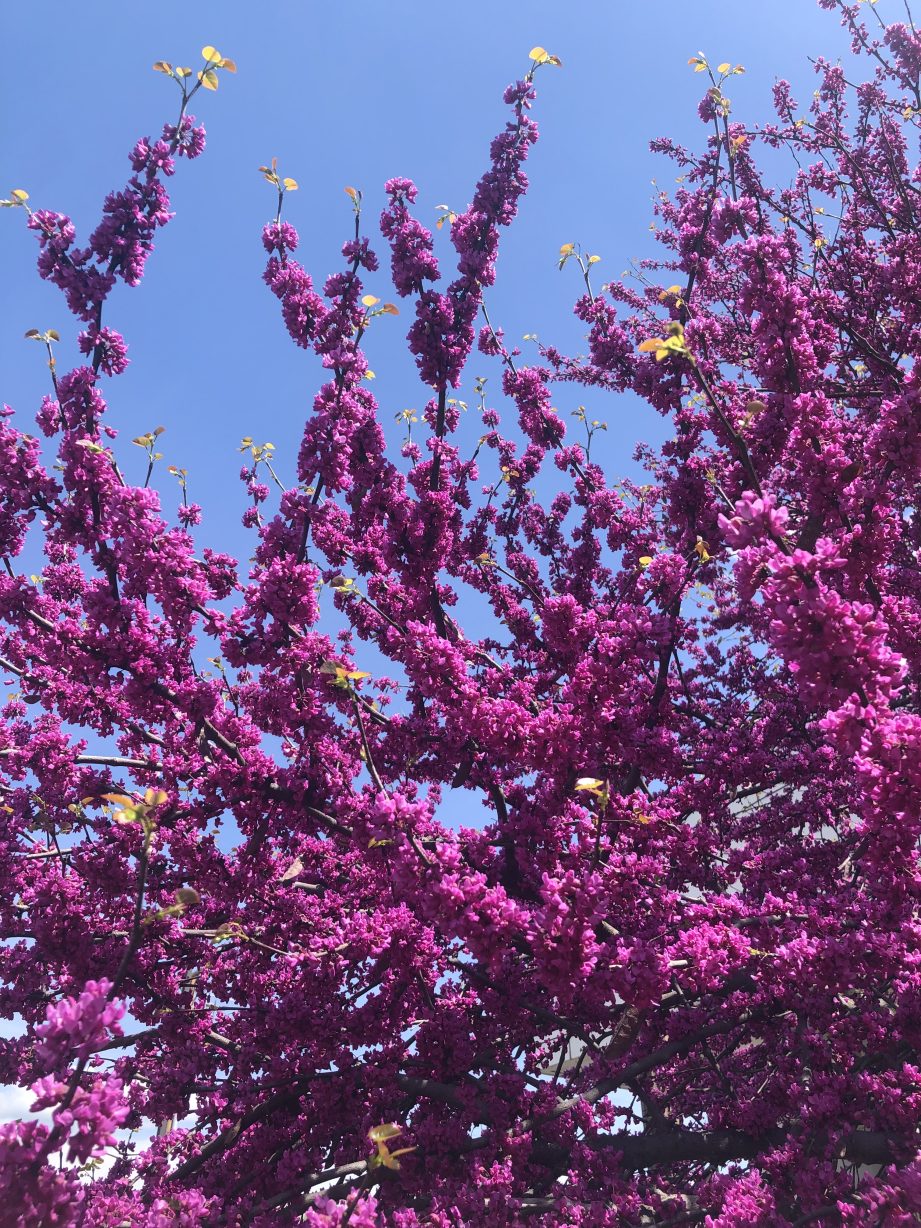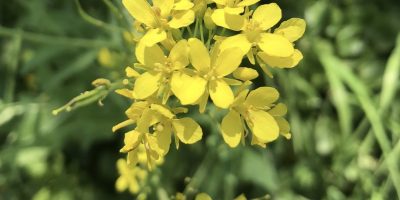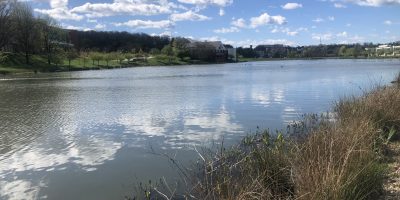
By Sofia Samatar
“The Friendly City” is a weekly column about walking in Harrisonburg that will run during 2024. Each week, your friendly correspondent, writer and teacher Sofia Samatar, will reflect on a walk in our city.
Look at this row of redbuds! Stunning—the clusters of violet-pink flowers blooming right on the branches, bursting from the bark. The word redbud fully describes the blossoming tree, a single color devoid of green: the special austerity, the purity of the redbud.
Weeks ago, it appeared they had bloomed, when dots of brightness came out along the branches. But now the flowers are so incredibly thick, the branches no longer look speckled with color—they’re layered, smothered, the flowers not buttoned on like dogwood blooms but piped on as if by an expert pastry chef, so that the branches, the trunks, and certain entire streets of the Friendly City are frosted with fabulous pink icing.
The redbud is a native tree; it grows here like a weed. How can something so gorgeous come so cheap? Grizzled, leaning redbuds stand before the old high school, their flowers vivid against the tawny brick, the sage-green cannon of the veterans’ memorial, the flashing tints of the traffic on High Street. On this warm April day, their lush magenta color seems like a visible manifestation of the heat, pulsing in the light blue, faintly humid, silky sky, where clouds stray, some in puffs like stuffing pulled out of a cushion, others vapory like streaks left behind on a freshly cleaned window.
I have heard that the redbud is sometimes called a Judas tree, and that people often plant it next to a dogwood, which is associated with Christ. The dogwood flower has the shape of a cross, and a small crown of thorns can be discerned in its center; a legend says the cross was made from the wood of this tree. As for the Judas tree, folklore holds that Judas Iscariot hanged himself from a redbud, whose flowers were stained with shame or blood. I take this to mean there’s nothing sacred about a redbud. It’s the tree of flawed, fallen humanity. In this valley, it grows everywhere.
The redbud sprouts in tiny yards, among the little houses across High Street, up against the porches crowded with grills, bicycles, and brooms, in the knot of lanes that dead-ends against the railroad track—a neighborhood with a youthful feel, maybe because it’s near the university, or because the dingy siding and abandoned soccer balls evoke young families with lots of energy and little ready cash. Or maybe it’s simply because young people have to live somewhere, and it’s hard to imagine a young person buying a house on the other side of High Street, where the yards are larger and the houses statelier, in this town where housing prices have doubled in less than a decade. So I imagine they’re here, the young folks, that these are their hammocks and ping-pong paddles under the redbuds. And when I cross High Street and enter the Sunset Heights neighborhood, I picture an older population, people who have lived here long enough to cultivate the gardens smelling pungently of mulch.
Tall, rangy redbuds let down their purple hair in these landscaped bowers, among the stone birdbaths and beds of pansies, as they do among the dandelions and forgotten, mold-spotted sneakers on the other side of High Street. The redbud listens at kitchen windows all over the Friendly City. It sees our shadows pass through the rooms in the grayish early light. It is there when the red stove light comes on, when the coffee maker clears its throat, when the open refrigerator door throws a band of cold light over the tiles. It hears our groans, our cheers, our laughter, our complaints. Someone says, I can’t run up any more debt. A child squeals, It’s my birthday! Someone steps out on a porch, eyes glazed, too startled by love to notice the brilliant blooms. Someone clutches a banister shaded by a redbud branch outside the window, wondering: How, after all my work, has it come to this? In the bruised light of the flowering tree, someone sits down carefully on a porch step, stunned by a sudden pain.
From a luscious cake—its edible blossoms adding a sweet tang to our salads—the redbud will morph into a barbed insect, its branches tipped with the greenish, red-veined spikes I can already see on a few trees during today’s walk. Next the heart-shaped leaves will come, filling out the tree, which will turn into a rustling, many-tiered palace, the fringes of its seed pods hanging down like carpets flung over the balconies or long trailing curtains. Finally, when the leaves fall, only the seed pods will remain, rattling dryly in the wind like fairy slippers hung up after a dance. What will have happened during all those months? Where will we be then?
The redbud in our yard was a castoff, a piece of junk, a thin switch about two feet long pulled from a tree a few miles away at our uncle’s house. We stuck it in the ground, and almost overnight, it seemed, it became a luxuriant, leafy tree. I continue to be surprised at the height of this tree, its rapid growth. I delight in its spring color filling the little front yard, its frilled parasol that shades the porch on hot summer afternoons, and its benevolent influence that reaches even the interior of the house, when, at seven o’clock on a June evening, the lavish, flamelike shadows of the leaves play over the curtains, the floor, the coffee table, the piano, and the wall opposite the sinking sun, imparting a coolness and liveliness to the whole house, an alternation of sun and silhouette so appealing, and so essentially a part of the long summer twilights, that I remember the time before the redbud tree with a scandalized feeling. How did we ever put up with the dry glare of a treeless sunset in midsummer? How sad the yard was then—a bald square like a postage stamp stuck to the street! I love the redbud for its range, its impudent occupation of space, and its cunning will to transform its surroundings, which we battle by pulling up the volunteer seedlings it drops all over the place and hacking back the branches that try to embrace the sidewalk.











